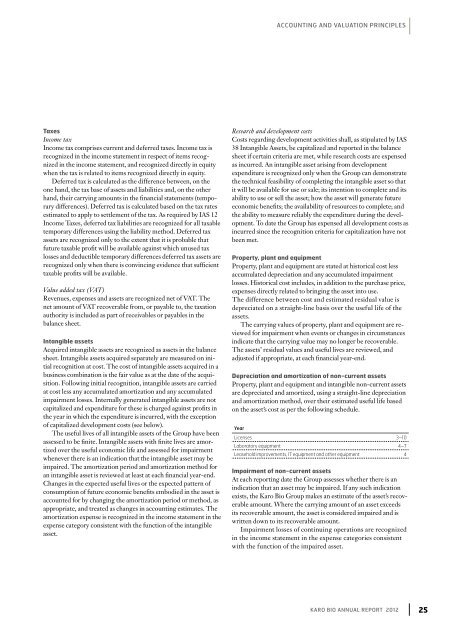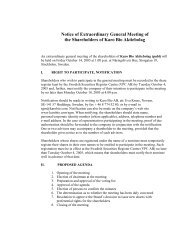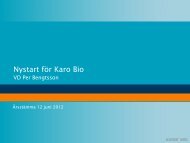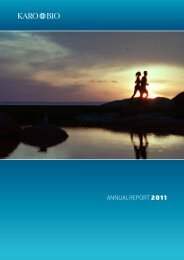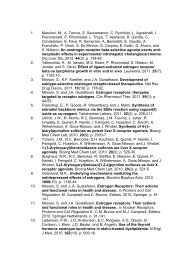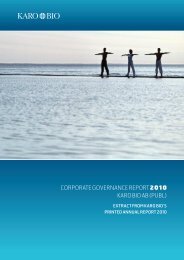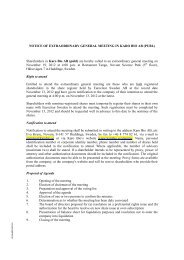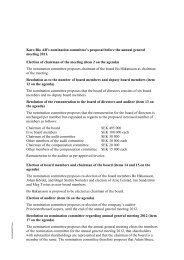Annual Report 2012.pdf - Karo Bio
Annual Report 2012.pdf - Karo Bio
Annual Report 2012.pdf - Karo Bio
Create successful ePaper yourself
Turn your PDF publications into a flip-book with our unique Google optimized e-Paper software.
Accounting and valuation principles<br />
Taxes<br />
Income tax<br />
Income tax comprises current and deferred taxes. Income tax is<br />
recognized in the income statement in respect of items recognized<br />
in the income statement, and recognized directly in equity<br />
when the tax is related to items recognized directly in equity.<br />
Deferred tax is calculated as the difference between, on the<br />
one hand, the tax base of assets and liabilities and, on the other<br />
hand, their carrying amounts in the financial statements (temporary<br />
differences). Deferred tax is calculated based on the tax rates<br />
estimated to apply to settlement of the tax. As required by IAS 12<br />
Income Taxes, deferred tax liabilities are recognized for all taxable<br />
temporary differences using the liability method. Deferred tax<br />
assets are recognized only to the extent that it is probable that<br />
future taxable profit will be available against which unused tax<br />
losses and deductible temporary differences deferred tax assets are<br />
recognized only when there is convincing evidence that sufficient<br />
taxable profits will be available.<br />
Value added tax (VAT)<br />
Revenues, expenses and assets are recognized net of VAT. The<br />
net amount of VAT recoverable from, or payable to, the taxation<br />
authority is included as part of receivables or payables in the<br />
balance sheet.<br />
Intangible assets<br />
Acquired intangible assets are recognized as assets in the balance<br />
sheet. Intangible assets acquired separately are measured on initial<br />
recognition at cost. The cost of intangible assets acquired in a<br />
business combination is the fair value as at the date of the acquisition.<br />
Following initial recognition, intangible assets are carried<br />
at cost less any accumulated amortization and any accumulated<br />
impairment losses. Internally generated intangible assets are not<br />
capitalized and expenditure for these is charged against profits in<br />
the year in which the expenditure is incurred, with the exception<br />
of capitalized development costs (see below).<br />
The useful lives of all intangible assets of the Group have been<br />
assessed to be finite. Intangible assets with finite lives are amortized<br />
over the useful economic life and assessed for impairment<br />
whenever there is an indication that the intangible asset may be<br />
impaired. The amortization period and amortization method for<br />
an intangible asset is reviewed at least at each financial year-end.<br />
Changes in the expected useful lives or the expected pattern of<br />
consumption of future economic benefits embodied in the asset is<br />
accounted for by changing the amortization period or method, as<br />
appropriate, and treated as changes in accounting estimates. The<br />
amortization expense is recognized in the income statement in the<br />
expense category consistent with the function of the intangible<br />
asset.<br />
Research and development costs<br />
Costs regarding development activities shall, as stipulated by IAS<br />
38 Intangible Assets, be capitalized and reported in the balance<br />
sheet if certain criteria are met, while research costs are expensed<br />
as incurred. An intangible asset arising from development<br />
expenditure is recognized only when the Group can demonstrate<br />
the technical feasibility of completing the intangible asset so that<br />
it will be available for use or sale; its intention to complete and its<br />
ability to use or sell the asset; how the asset will generate future<br />
economic benefits; the availability of resources to complete; and<br />
the ability to measure reliably the expenditure during the development.<br />
To date the Group has expensed all development costs as<br />
incurred since the recognition criteria for capitalization have not<br />
been met.<br />
Property, plant and equipment<br />
Property, plant and equipment are stated at historical cost less<br />
accumulated depreciation and any accumulated impairment<br />
losses. Historical cost includes, in addition to the purchase price,<br />
expenses directly related to bringing the asset into use.<br />
The difference between cost and estimated residual value is<br />
depreciated on a straight-line basis over the useful life of the<br />
assets.<br />
The carrying values of property, plant and equipment are reviewed<br />
for impairment when events or changes in circumstances<br />
indicate that the carrying value may no longer be recoverable.<br />
The assets’ residual values and useful lives are reviewed, and<br />
adjusted if appropriate, at each financial year-end.<br />
Depreciation and amortization of non-current assets<br />
Property, plant and equipment and intangible non-current assets<br />
are depreciated and amortized, using a straight-line depreciation<br />
and amortization method, over their estimated useful life based<br />
on the asset’s cost as per the following schedule.<br />
Year<br />
Licenses 3–10<br />
Laboratory equipment 4–7<br />
Leasehold improvements, IT equipment and other equipment 4<br />
Impairment of non-current assets<br />
At each reporting date the Group assesses whether there is an<br />
indication that an asset may be impaired. If any such indication<br />
exists, the <strong>Karo</strong> <strong>Bio</strong> Group makes an estimate of the asset’s recoverable<br />
amount. Where the carrying amount of an asset exceeds<br />
its recoverable amount, the asset is considered impaired and is<br />
written down to its recoverable amount.<br />
Impairment losses of continuing operations are recognized<br />
in the income statement in the expense categories consistent<br />
with the function of the impaired asset.<br />
KARO BIO <strong>Annual</strong> <strong>Report</strong> 2012 25


